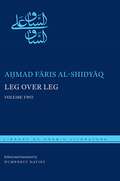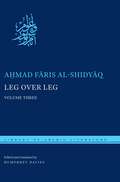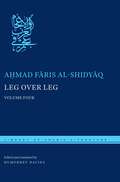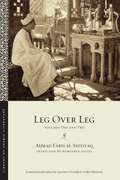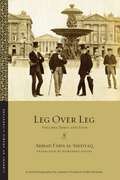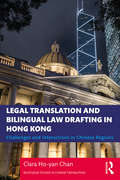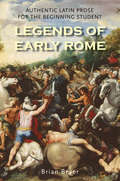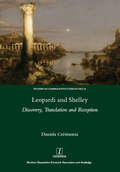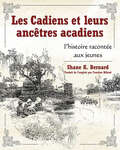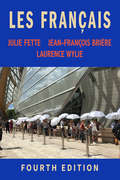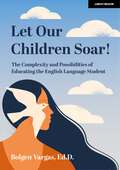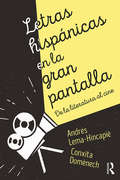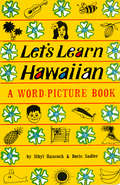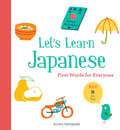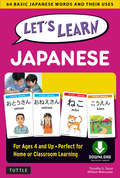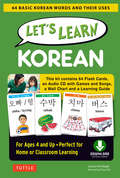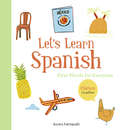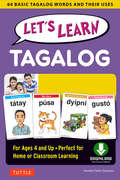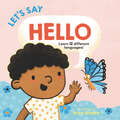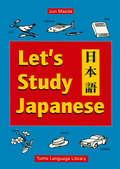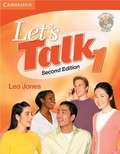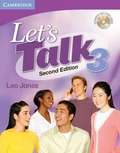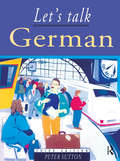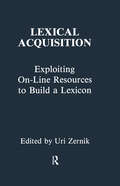- Table View
- List View
Leg over Leg: Volume Two (Library of Arabic Literature #27)
by Humphrey Davies Ahmad Faris al-ShidyaqLeg over Leg recounts the life, from birth to middle age, of 'the Fariyaq,' alter ego of Ahmad Faris al-Shidyaq, a pivotal figure in the intellectual and literary history of the modern Arab world. The always edifying and often hilarious adventures of the Fariyaq, as he moves from his native Lebanon to Egypt, Malta, Tunis, England and France, provide the author with grist for wide-ranging discussions of the intellectual and social issues of his time, including the ignorance and corruption of the Lebanese religious and secular establishments, freedom of conscience, women's rights, sexual relationships between men and women, the manners and customs of Europeans and Middle Easterners, and the differences between contemporary European and Arabic literatures. Al-Shidyaq also celebrates the genius and beauty of the classical Arabic language.<P><P> Akin to Sterne and Rabelais in his satirical outlook and technical inventiveness, al-Shidyaq produced in Leg Over Leg a work that is unique and unclassifiable. It was initially widely condemned for its attacks on authority, its religious skepticism, and its "obscenity," and later editions were often abridged. This is the first English translation of the work and reproduces the original Arabic text, published under the author's supervision in 1855.
Leg over Leg: Volume Three (Library of Arabic Literature #34)
by Humphrey Davies Ahmad Faris al-ShidyaqLeg over Leg recounts the life, from birth to middle age, of 'the Fariyaq,' alter ego of Ahmad Faris al-Shidyaq, a pivotal figure in the intellectual and literary history of the modern Arab world. The always edifying and often hilarious adventures of the Fariyaq, as he moves from his native Lebanon to Egypt, Malta, Tunis, England and France, provide the author with grist for wide-ranging discussions of the intellectual and social issues of his time, including the ignorance and corruption of the Lebanese religious and secular establishments, freedom of conscience, women's rights, sexual relationships between men and women, the manners and customs of Europeans and Middle Easterners, and the differences between contemporary European and Arabic literatures. Al-Shidyaq also celebrates the genius and beauty of the classical Arabic language.<P><P> Akin to Sterne and Rabelais in his satirical outlook and technical inventiveness, al-Shidyaq produced in Leg Over Leg a work that is unique and unclassifiable. It was initially widely condemned for its attacks on authority, its religious skepticism, and its "obscenity," and later editions were often abridged. This is the first English translation of the work and reproduces the original Arabic text, published under the author's supervision in 1855.
Leg over Leg: Volume Four (Library of Arabic Literature #30)
by Humphrey Davies Ahmad Faris al-ShidyaqLeg over Leg recounts the life, from birth to middle age, of 'the Fariyaq,' alter ego of Ahmad Faris al-Shidyaq, a pivotal figure in the intellectual and literary history of the modern Arab world. The always edifying and often hilarious adventures of the Fariyaq, as he moves from his native Lebanon to Egypt, Malta, Tunis, England and France, provide the author with grist for wide-ranging discussions of the intellectual and social issues of his time, including the ignorance and corruption of the Lebanese religious and secular establishments, freedom of conscience, women's rights, sexual relationships between men and women, the manners and customs of Europeans and Middle Easterners, and the differences between contemporary European and Arabic literatures. Al-Shidyaq also celebrates the genius and beauty of the classical Arabic language. Akin to Sterne and Rabelais in his satirical outlook and technical inventiveness, al-Shidyaq produced in Leg Over Leg a work that is unique and unclassifiable. It was initially widely condemned for its attacks on authority, its religious skepticism, and its "obscenity," and later editions were often abridged. This is the first English translation of the work and reproduces the original Arabic text, published under the author's supervision in 1855.
Leg over Leg: Volumes One and Two (Library of Arabic Literature #1)
by Humphrey Davies Ahmad Faris al-ShidyaqLeg over Leg recounts the life, from birth to middle age, of "the Fariyaq," alter ego of Ahmad Faris al-Shidyaq, a pivotal figure in the intellectual and literary history of the modern Arab world. The always edifying and often hilarious adventures of the Fariyaq, as he moves from his native Lebanon to Egypt, Malta, Tunis, England, and France, provide the author with grist for wide-ranging discussions of the intellectual and social issues of his time, including the ignorance and corruption of the Lebanese religious and secular establishments, freedom of conscience, women's rights, sexual relationships between men and women, the manners and customs of Europeans and Middle Easterners, and the differences between contemporary European and Arabic literatures, all the while celebrating the genius and beauty of the classical Arabic language. Volumes One and Two follow the hapless Fariyaq through his youth and early education, his misadventures among the monks of Mount Lebanon, his flight to the Egypt of Muhammad 'Ali, and his subsequent employment with the first Arabic daily newspaper--during which time he suffers a number of diseases that parallel his progress in the sciences of Arabic grammar, and engages in amusing digressions on the table manners of the Druze, young love, snow, and the scandals of the early papacy. This first book also sees the list--of locations in Hell, types of medieval glue, instruments of torture, stars and pre-Islamic idols--come into its own as a signature device of the work. Akin to Sterne and Rabelais in his satirical outlook and technical inventiveness, al-Shidyaq produced in Leg Over Leg a work that is unique and unclassifiable. It was initially widely condemned for its attacks on authority, its religious skepticism, and its "obscenity," and later editions were often abridged. This is the first complete English translation of this groundbreaking work.
Leg over Leg: Volumes Three and Four (Library of Arabic Literature #9)
by Humphrey Davies Ahmad Faris al-Shidyaq<P> Leg over Leg recounts the life, from birth to middle age, of “the Fariyaq,” alter ego of Ahmad Faris al-Shidyaq, a pivotal figure in the intellectual and literary history of the modern Arab world. The always edifying and often hilarious adventures of the Fariyaq, as he moves from his native Lebanon to Egypt, Malta, Tunis, England, and France, provide the author with grist for wide-ranging discussions of the intellectual and social issues of his time, including the ignorance and corruption of the Lebanese religious and secular establishments, freedom of conscience, women’s rights, sexual relationships between men and women, the manners and customs of Europeans and Middle Easterners, and the differences between contemporary European and Arabic literatures, all the while celebrating the genius and beauty of the classical Arabic language. <P> Volumes Three and Four see the peripatetic Fariyaq fall in love and convert to Catholicism for twenty-four hours in order to marry. Although the narrative revolves around a series of debates over the nature of male-female relationships, opportunities also arise for disquisitions on the physical and moral significance of such diverse topics as the buttocks, the unreliability of virginity tests, and the human capacity for self-delusion. Lengthy stays in England and France allow for animadversions on the table manners and sexual aberrations of their citizens, but the discussion, whether it involve dance-halls, pleasure gardens, or poetry, almost always ends up returning to gender relations. <P> Akin to Sterne and Rabelais in his satirical outlook and technical inventiveness, al-Shidyaq produced in Leg Over Leg a work that is unique and unclassifiable. It was initially widely condemned for its attacks on authority, its religious skepticism, and its “obscenity,” and later editions were often abridged. This is the first complete English translation of this groundbreaking work.
Legal Translation and Bilingual Law Drafting in Hong Kong: Challenges and Interactions in Chinese Regions (Routledge Studies in Chinese Translation)
by Clara Ho-yan ChanLegal Translation and Bilingual Law Drafting in Hong Kong presents a systematic account from a cross-disciplinary perspective of the activities of legal translation and bilingual law drafting in the bilingual international city of Hong Kong and its interaction with Mainland China and Taiwan in the use of legal terminology. The study mainly examines the challenges posed to English-Chinese translation in the past three decades by elaborate drafting and terminological equivalence, and offers educational and research solutions. Its primary goals are to create legal Chinese that naturally accommodates common law concepts and statutes from the English legal system and to reconcile Chinese legal terms from the different legal systems adopted by Hong Kong, Mainland China and Taiwan. The new directions in legal translation and bilingual law drafting in Hong Kong will have implications for other Chinese regions and for the world. The book is intended for scholars, researchers, teachers and students of legal translation and legal linguistics, legal translators, lawyers and legal practitioners who are engaged in translation, as well as all persons who are interested in legal language and legal translation.
Legends of Early Rome
by Brian BeyerIn this text for upper-beginner and intermediate students, Brian Beyer collects authentic Latin prose from Book I of Eutropius's Breviarium ab urbe condita, which covers Roman history from Rome's foundation to the sack of Rome by the Gauls. Eutropius's easy style and accessible vocabulary make his Breviarium ideal for students transitioning from the simplified Latin of a first-year textbook. Bottom-of-the-page glosses, passages in English from the Roman historian Livy, a running commentary on grammar and syntax, historical notes, and compiled vocabulary allow students insight into the foundational myths of ancient Rome and the historical context of Eutropius's narrative.
Leopardi and Shelley: Discovery, Translation and Reception
by Cerimonia DanielaGiacomo Leopardi (1798-1837) and Percy Bysshe Shelley (1792-1822) crossed paths during their lifetimes, and though they never met, the legacy of their work betrays a shared destiny. As prominent figures who challenged and contributed to the Romantic debate, Leopardi and Shelley hold important roles in the history of their respective national literatures, but paradoxically experienced a controversial and delayed reception outside their native lands. Cerimonia�s wide-ranging study brings together these two poets for the first time for an exploration of their afterlives, through a close reading of hitherto unstudied translations. This intriguing journey tells the story, from its origins, of the two poets� critical fortune, and examines their position in the cultural debates of the nineteenth century; in disputes regarding translation theories and practices; and shows the configuration of their identities as we understand their legacy today.
Les Cadiens et leurs ancêtres acadiens: l'histoire racontée aux jeunes
by Shane K. BernardCajuns and Their Acadian Ancestors: A Young Reader's History traces the four-hundred-year history of this distinct American ethnic group. In its original English, the book proved a perfect package, comprehensible to junior-high and high-school students, while appealing to and informing adult readers seeking a one-volume exploration of these remarkable people and their predecessors. It is now available for the first time translated into French. The narrative follows the Cajuns' early ancestors, the Acadians, from seventeenth-century France to Nova Scotia, where they flourished until British soldiers expelled them in a tragic event called Le Grand Dérangement (The Great Upheaval)—an episode regarded by many historians as an instance of ethnic cleansing or genocide. Up to one-half of the Acadian population died from disease, starvation, exposure, or outright violence in the expulsion. Nearly three thousand survivors journeyed through the thirteen American colonies to Spanish-controlled Louisiana. There they resettled, intermarried with members of the local population, and evolved into the Cajun people, who today number over a half-million. Since their arrival in Louisiana, the Cajuns have developed an unmistakable identity and a strong sense of ethnic pride. In recent decades they have contributed their lively cuisine and accordion-and-fiddle dance music to American popular culture. Les Cadiens et leurs ancêtres acadiens: l'histoire racontée aux jeunes includes numerous images and over a dozen sidebars on topics ranging from Cajun music and horse racing heroes to Mardi Gras. Shane K. Bernard's welcomed and cherished history of the Cajun people is translated into French by Faustine Hillard. The book offers a long-sought immersion text, ideal for the young learner and adult alike. Intended to appeal to both native French-speakers as well as to English-speaking students who are learning French, this French translation of Shane K. Bernard's Cajuns and Their Acadian Ancestors: A Young Reader's History is perfect for middle-school and high-school readers enrolled in conversational and French Immersion classes. Adult readers of French will also find it a useful primer of Acadian and Cajun history. Les Cadiens et leurs ancêtres acadiens : l'histoire racontée aux jeunes retrace le périple de quatre siècles de ce groupe ethnique nord-américain distinct des autres. Accessible aux adolescents, ce volume s'avérera également utile et pratique pour le lecteur adulte qui cherche à connaître à la fois ce peuple remarquable et ses ancêtres. Le récit suit la trace des Acadiens, les premiers ancêtres des Cadiens, de la France du dix-septième siècle à la Nouvelle-Écosse, là où ils se sont épanouis jusqu'à ce que des soldats britanniques les expulsent lors de cet évènement tragique que fut Le grand dérangement—un triste épisode qui a débuté en 1755 et que nombre d'historiens modernes considèrent comme un parfait exemple de nettoyage ethnique, voire de génocide. Près de trois mille survivants ont (péniblement) traversé les treize colonies américaines pour se rendre jusqu'en Louisiane, alors sous le régime espagnol. Là, ils s'installent à nouveau, s'intègrent à la population locale par le biais du mariage et forment peu à peu ce qu'il est aujourd'hui convenu d'appeler le peuple cadien. Aujourd'hui, on compte plus d'un demi-million d'habitants d'origine cadienne en Louisiane.
Les Français
by Julie Fette Jean-François Brière Laurence WylieThoroughly revised and updated to reflect changes in French society over the last generation, and now illustrated with full-color photos, the Fourth Edition of Les Français retains hallmarks of the pioneering work in cultural anthropology that distinguished Laurence Wylie's First Edition—work that has long since helped make Les Français the most illuminating French-language introduction to French society and culture for the needs of North American students. The Fourth Edition also remains rooted in the comparative approach of previous editions, analyzing outlooks and practices that undergird the social fabric of France from the perspective of those approaching them from a North American background. Ranging from discussions of distinctively French perspectives on time, space, human nature, and the body, to norms of childhood socialization and family life, to the key elements and entities of social and cultural life, Les Français illustrates ways in which the French are "made not born," all while pointing up contradictions and paradoxes in French life and reflecting the greatly diversified demographic and social makeup of today's France.
Let Our Children Soar! The Complexity and Possibilities of Educating the English Language Student
by Bolgen Vargas Ed.D.This is a story about English language learners - one in particular - and a reflection on what we, as educators, can do to promote their success.As educators, we're faced every day with the question of how to teach the thousands - many thousands - of children who arrive in our schools as immigrants and refugees, coming with no English, from cultural backgrounds so different from America's, often from impoverished households and often from households where education of the kind we know was completely absent.Our work as educators is to help these children start to climb the wall that stands between their past, wherever and however that was lived, and a future in America, where their education will prepare them to take advantage of the same opportunities everyone else here enjoys.This is not an easy job. But it's one we can't afford to get wrong. And this is not a small corner in our education system today. The number of English language learners in U.S. school systems is large and growing. And the educators involved in teaching this exceptional population include basically everyone, not just those teachers with direct classroom contact. When they're in the building, the entire school is the English language learner's world.
Let Our Children Soar! The Complexity and Possibilities of Educating the English Language Student
by Bolgen Vargas Ed.D.This is a story about English language learners - one in particular - and a reflection on what we, as educators, can do to promote their success.As educators, we're faced every day with the question of how to teach the thousands - many thousands - of children who arrive in our schools as immigrants and refugees, coming with no English, from cultural backgrounds so different from America's, often from impoverished households and often from households where education of the kind we know was completely absent.Our work as educators is to help these children start to climb the wall that stands between their past, wherever and however that was lived, and a future in America, where their education will prepare them to take advantage of the same opportunities everyone else here enjoys.This is not an easy job. But it's one we can't afford to get wrong. And this is not a small corner in our education system today. The number of English language learners in U.S. school systems is large and growing. And the educators involved in teaching this exceptional population include basically everyone, not just those teachers with direct classroom contact. When they're in the building, the entire school is the English language learner's world.
Letras hispánicas en la gran pantalla: De la literatura al cine
by Andrés Lema-Hincapié Conxita DomènechLetras Hispánicas en la Gran Pantalla is an innovative textbook for advanced students of Hispanic studies, which merges the studies of canonical literary works and their film adaptions. Students are guided through key literary masterpieces spanning from the Renaissance to the present day while, at the same time, interpreting their film versions. This parallel approach encourages students to develop their analytical skills as they master the terminology of contemporary studies in literature and cinema. Exploring complete works by both male and female authors and directors from Argentina, Chile, Colombia, Costa Rica, Mexico, and Spain, Letras Hispánicas en la Gran Pantalla allows students discover the astounding diversity of the Spanish-speaking world, in a unique and engaging way.
Let's Learn Hawaiian: A Word-Picture Book
by Doris Sadler Sibyl HancockAloha! Welcome to Hawaii! Travel through the pages of this very charming word-and-picture storybook.The many attractively arranged illustrations will have special appeal for children. The words here are simple ones we might use everyday. <P><P>There is laughter here, too--so important to keep a child's attention and help put an idea across.But it is not only children who can benefit from this presentation, a unique arrangement of pictures and facts about Hawaii. It should be of particular interest to adults and parents, teachers in the classroom, travelers to the Islands, or those simply interested in learning something about Hawaii, its language and traditions.Come with us to taste a fresh white niu, hear an old Hawaiian mele, or wiggle your toes in the moana. Some of the charms and flavor of the Islands are here; we hope that you will find it and want to come back to read this Hawaiian picture storybook again and again!
Let's Learn Japanese: First Words for Everyone
by Aurora CacciapuotiAn accessible introduction to the rich language and culture of Japan, this tote-able Japanese language collection makes an artful addition to any library, as well as an ideal travel primer and companion for aspiring Japanese speakers. Pairing words and characters with whimsical illustrations, each section features examples of word pronunciation, the three main Japanese writing systems (kanji, hiragana, and katakana), and common Japanese elements. At once instructive and a joy to behold, Let's Learn Japanese is a go-to gift for the world traveler and language learner.
Let's Learn Japanese: 64 Basic Japanese Words and Their Uses (Downloadable Audio Included)
by William MatsuzakiA kid friendly introduction to Japanese!Let's Learn Japanese is an introductory Japanese language learning tool especially designed to help children from preschool through early elementary level acquire basic words, kanji characters, phrases, and sentences in Japanese in a fun and easy way. The flashcards can be used as a learning tool in a classroom setting, at home, or anywhere that learning takes place, and can easily be taped around the room for an interactive way to learn Japanese. It contains: 64 Japanese flash cards Downloadable audio with recordings of songs, games and activities A wall chart showing the main words and phrases at a glance A learning guide for parents and teachers The flash cards present 64 basic words and phrases representing the full range of sounds in Japanese and organized into thematic categories, including: People Colors Animals Food Body Prts Clothing Going Places Also included in this Japanese for kids is downloadable audio which provides native pronunciation of the words, and sample sentences for practice-sentences that children would use in everyday life. Songs and other activities are also included on the free downloadable audio.
Let's Learn Korean
by Tina ChoWelcome to a Korean language learning adventure--designed to make learning fun! TheLet's Learn Korean kit is an introductory language learning tool especially designed to help children from preschool through early elementary level acquire basic words, phrases, and sentences in Korean in a fun and easy way. The flashcards can be used as a learning tool in a classroom setting, at home, or anywhere that learning takes place, and can easily be taped around the room for an interactive learning experience. This Korean flash cards for kids kit contains: 64 Flash Cards (4. 25" x 2. 7") that get children talking--about Numbers, Colors, Going Places, and more. Everyday words and sentences help children learn naturally. Audio CD provides native pronunciation of the Korean words, and sample sentences for practice--plus Korean songs that help make learning fun. Color Wall Chart (24" x 18") keeps all the new vocabulary in sight. Learning Guide for Parents and Teachers 32 ages tells you how to use the cards for most effective learning, and includes activities and games to play with your kids.
Let's Learn Spanish: First Words for Everyone
by Aurora CacciapuotiAccessible introduction to Spanish language and Mexican cultureLearning Spanish is just a few pictures away in this lovingly illustrated picture book language primer! Focusing on the Spanish language as it is spoken in Mexico, this informative picture book is an ideal way to learn. Pairing words and whimsical pictures, aspiring Spanish speakers are treated to a breezy yet informative experience. Let's Learn Spanish is a go-to ebook for the world traveler and language learner.• Fantastic primer for Spanish language learners young and old!• Perfect for anyone traveling to Mexico or South America.• Aurora Cacciapuoti is an author and illustrator of more than a dozen children's books.This informative Spanish language primer will appeal to readers of Little Concepts: ABC Spanish, First Words – Spanish, and My Big Book of Spanish Words.• For kids ages 4 to 8• Learn Spanish for kids, preschool, kindergarten• Perfect travel companion
Let's Learn Tagalog: 64 Basic Tagalog Words and Their Uses-For Children Ages 4 and Up
by Imelda Fines GasmenLet's Learn Tagalog Kit is a complete language learning tool specially designed to introduce young children to the basic Tagalog sounds, words, and phrases in a fun and interactive way. <P><P> This kit is perfect for use in a classroom setting, for home schooling, on vacation, or anywhere else that learning takes place. It is intended for learners who have little or no background in the Tagalog language. It contains: 64 flash cards An audio CD with recordings of words, sentences and songs A wall chart showing the main words and phrases at a glance A 32-page Learning Guide for parents and teachers The 64 words are organized into thematic categories, including: My Family Colors Numbers Animals Food My Body Clothes My Day Each word is illustrated with a picture that serves as an effective visual aid to learning and remembering the word. The words often reflect cultural objects and can be studied in any order. Tagalog language learners may focus on one theme at a time or mix them up for greater variety. Simple example sentences are given for each word to show how they are used. The audio CD gives native-speaker pronunciations for all the words and sentences and also contains songs which promote interactive language learning. Finally, the kit includes a wall chart featuring all the pictures and words, and some bonus words; a booklet explaining how to use the flash cards, and additional activities; an audio CD and a wall chart.
Let's Say Hello (Baby's First Language Book)
by Giselle AngTeach babies to greet others in twelve different languages with this adorable multilingual board book! Get ready, everyone! LET’S SAY...HELLO. A perfect companion to Disney’s "It's a Small World" and Shirley Ng-Benitez’s How Do You Say series, Let’s Say board books teach tiny tots warm and friendly words/phrases in several languages. Each book features: twelve diverse languages: American Sign Language, Arabic, French, German, Haitian Creole, Hausa, Hindi, Italian, Japanese, Mandarin Chinese, Russian, Spanish vibrant and colorful illustrations easy-to-read pronunciations/demonstrations kid-friendly illustrations of everyday babies from around the world An ideal baby shower or first-day-of-school gift!
Lets Study Japanese
by Jun Maeda"In this jet age, one can reach any part of the world within a day or two. It is wise to have some knowledge of the language of the country one visits to make the trip enjoyable and worthwhile. " -THE AUTHORJun Maeda has purposely written Let's Study Japanese for the tourist visiting Japan, although the book will undoubtedly prove its worth to anyone wanting to acquire a working knowledge of spoken Japanese in short order. With approximately 350 essential words and 130 pages of practical conversational usage, this handy book provides the basics needed to converse in simple Japanese. Intended for beginners, the book concentrates only on key grammar and pronounciation points. Most of the 26 lessons include exercises that reinforce vocabulary items and grammatical structures. Phrases and sentences are recycled for long-term learning. Over 200 simple illustrations allow even beginners to express themselves. in short, Let's Study Japanese is an introduction to basic Japanese that is concise, simple, and useful from the very first page.
Let's Talk 1 (2nd Edition)
by Leo JonesLet's Talk 1, Second Edition, is for students at the high-beginning/low-intermediate level. Features of the Student's Book include more systematic presentation and recycling of structures and vocabulary, an increased focus on communication activities, and new Expansion review sections after every four units. The expanded self-study section now includes grammar, listening, and vocabulary practice, offering students additional opportunities to review and consolidate the material. The grammar paradigms and listening text are included on the Self-Study Audio CD packaged with the Student's Book.
Let’s Talk 3 (Second Edition)
by Leo JonesLet's Talk 3, Second Edition, is for students at the high-intermediate level. Features of the Student's Book include more systematic presentation and recycling of structures and vocabulary, an increased focus on communication activities, and new Expansion review sections after every four units.
Let's Talk German: Pupil's Book 3rd Edition
by Peter SuttonA German language course for adult beginners, both independent learners and those following adult education courses. It has been updated to reflect developments in the language and culture of German-speaking nations, and also the political changes in Germany. Audio files to accompany the book are available to download from www.routledge.com/cw/sutton .
Lexical Acquisition: Exploiting On-line Resources To Build A Lexicon
by Uri ZernikOn-line information -- and free text in particular -- has emerged as a major, yet unexploited, resource available in raw form. Available, but not accessible. The lexicon provides the major key for enabling accessibility to on-line text. The expert contributors to this book explore the range of possibilities for the generation of extensive lexicons. In so doing, they investigate the use of existing on-line dictionaries and thesauri, and explain how lexicons can be acquired from the corpus -- the text under investigation -- itself. Leading researchers in four related fields offer the latest investigations: computational linguists cover the natural language processing aspect; statisticians point out the issues involved in the use of massive data; experts discuss the limitations of current technology; and lexicographers share their experience in the design of the traditional dictionaries.
